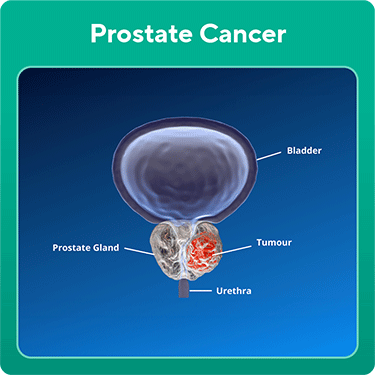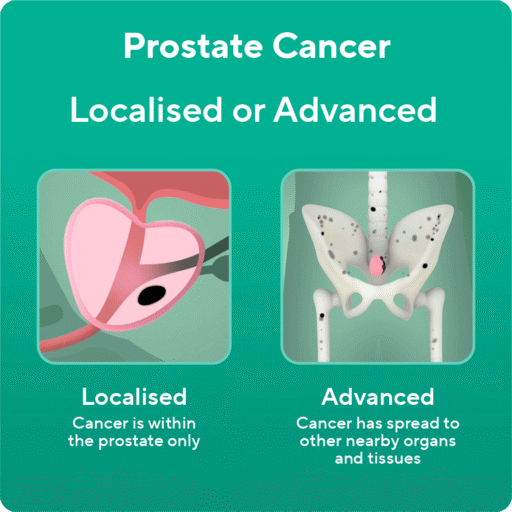The prostate is a walnut-sized gland that sits below the bladder in men. The prostate produces fluid that mixes with sperm cells to make up semen.
Prostate cancer results from abnormal cells developing in the prostate, dividing uncontrollably and forming tumours. Some types of prostate cancer grow very slowly and don’t cause any issues, so many men never need treatment. However, other types can grow quickly and need treatment to stop the cancer spreading.
Prostate cancer is one of the most common types of cancer in men in Australia, and it is more common in men aged over 50. More than 19,000 Australians are diagnosed each year.

Researchers still don’t know what causes prostate cancer, but some risk factors have been identified. These include:
• having a relative with prostate cancer
• being aged over 50
• having low fertility levels
• being overweight or obese.
Men rarely experience prostate cancer symptoms, particularly in the early stages. If the cancer has been present for years, or if it is an aggressive type, it may cause symptoms such as difficulty passing urine. However, this symptom can also occur in other health conditions, especially if the prostate is enlarged, so see your health care professional if you have difficulty passing urine.
If the prostate cancer is advanced, you may notice the following symptoms:
• unexplained weight loss
• frequent urination
• sudden need to urinate
• blood in the urine
• blood in the semen
• pain in the lower back, hips or pelvis.
If you notice any of these symptoms, see your health care professional.
There are several tests that can provide information about your prostate and whether you may have signs of prostate cancer. The tests themselves can’t diagnose prostate cancer, but they can indicate whether further exploration is advisable.
If any of these tests reveal numbers that aren’t considered normal, the next step may be a biopsy to test for cancer cells. During a biopsy, your health care professional removes multiple small tissue samples from the prostate. The samples are sent to a lab where they will be studied to determine if they contain any cancer cells. If cancer is found, the sample may also reveal whether it is aggressive or slow-growing.
There are no general guidelines for prostate cancer testing, so it’s up to you to decide if you want to have it. There are benefits as well as risks to consider. Your decision may be based on your age, family medical history, and personal level of concern about your cancer risk.
One reason for choosing to be tested is that detecting prostate cancer early can allow you to decide whether to treat it or closely monitor it. All treatments have risks, and if the cancer is in the early stage, it may be low risk and not need treatment. However, if the cancer is not found until later and is spreading or high risk, you may have less choice about treatment.
Deciding whether to be tested for prostate cancer can be very daunting and difficult. Your urologist can help you understand the pros and cons, and likely potential outcomes, of testing.

The stages of prostate cancer describe where the cancer is, how serious it is and whether it has spread. Cancer can be either:
• localised – contained within the prostate only
• advanced – spread to other nearby organs and tissues (also known as ‘metastatic’).
Prostate cancer is also given a grade, called a ‘Gleason score’, based on what the pattern of cancer cell growth looks like under a microscope.
Knowing the cancer’s stage helps your health care professional to provide you with the best possible treatment.
There are different types of treatments for prostate cancer, and choosing what treatment to have can be difficult. A detailed discussion with your health care professional will help with the decision. The options available to you will be based on:
• how serious the cancer is – whether it is present only in the prostate (‘localised’)or has spread to nearby organs (‘advanced’, also known as ‘metastatic’)
• your PSA level and how it has changed over time
• your age and overall health status
• your treatment preferences.
The treatments available for prostate cancer include:
• surgery, to remove the prostate
• radiation therapy, to kill or shrink cancer cells
• chemotherapy, to destroy cancer cells by taking different types of medication
• androgen deprivation therapy (ADT), to stop the production of male hormones or block hormones from acting on cells and tissues.
Find out more about treatment and tests for prostate cancer
Remember, some cancers do not require active treatment. If your cancer doesn’t need treatment, your medical team will monitor you and identify any changes that suggest treatment may be needed in future.


